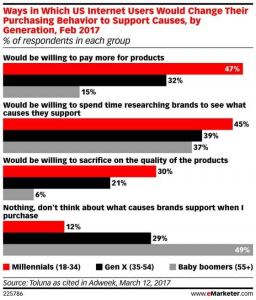Patients are now consumers. And with that comes a focus on getting high value at a low cost. So you can say it a medical shopping for patients. Health brands and medical providers must find ways to meet consumers where they are or be replaced with other alternatives.
Consumers want high value – and low cost. And they are not willing to sacrifice either.
With high deductible insurance plans skyrocketing, one thing holds true: quality reigns supreme.
And now, they won’t have to sacrifice – courtesy of recent medical pricing transparency mandates.
The decision-making and pricing power are gradually shifting away from doctors and insurance companies back to the consumer.
So what does this mean for the future of healthcare?
Consumers will comparison shop all of their healthcare needs.
The days of going with the closest medical provider are over. Instead, consumers will opt for higher quality and lower cost options. And, they’ll be able to find them – all online.
With online reviews on every search engine and via websites like Health Grades & Healthcare Bluebook, consumers can easily filter and vet thousands of providers in minutes.
Not to mention the medical pricing transparency that apps such as GoodRx and Qwikscripts provide, giving consumers complete access to online shop even their prescriptions.
But it’s how medical shopping will redefine the healthcare industry that should make you pay close attention.
1. Price Wars in Medical Shopping
Balancing high value with low costs to win
With the veil of “black box,” medical pricing lifted, consumers, hold all of the power. And when they can do medical shopping with various providers for the same treatments, the lowest cost will win every time.
As e-commerce and retail giants like Amazon and Walmart enter the healthcare space, consumers will expect low prices with amazing levels of quality. So, unless you can justify a higher price than your competitor, expect to be coerced by the market to lower your prices to attract new patients.
2. Promotional Competition
Partnering with other providers to add value
If cost is held constant across the board, consumers will look to what “freebie” services they can get for the same price. Whether it is offering free delivery on orders, giving promotional discounts to other service or medical providers, or adding in bundled packages for no additional charge, partnering to add value will be a must.
3. More Consolidation
Eliminating weak players from the market.
Not every business model can sustain offering low prices. Inevitably, those who cannot accommodate the market shift to affordable, high-quality bundled services will either go out of business or be acquired by larger players. As industry leaders actively search for ways to expand their services, without incurring higher costs, mergers and acquisitions will be a regular (and necessary) occurrence.
4. Better Marketing
Mastering direct response to create a sizable competitive advantage.
Going beyond selling just the features of a treatment or a service. And tapping into those psychological drivers is how you will be able to stand out from the low-cost crowd.
The key will be how you better position your marketing to get in front of your target audience at the right time and with the right message to move them to act.
For example, showcasing your corporate charitable causes often can be untapped. It’s a way to appeal to your customer’s philanthropic interests to capture more of the market.

With pricing and value offerings aside, how you market will be the differentiating factor. In two decades in direct response, I’ve seen firsthand that it is those companies that can tap into what consumers really want that have historically been and will continue to be the biggest winners.
